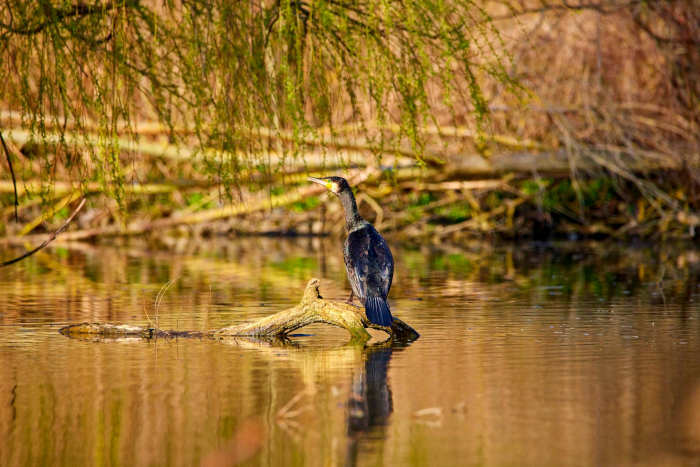
$4B EVERGLADES RESTORATION UNDERWAY

$4B EVERGLADES RESTORATION UNDERWAY
The restoration effort in the Everglades is the largest hydrological restoration project ever undertaken in the U.S and aims to improve the water supply and increase flood protection.
MIAMI – When Steve Davis jumped out of the airboat and into the water in the middle of the Everglades, it rose to just below his waist, higher than last year when it pooled around his knees.
“I’m standing in Miami-Dade’s water supply right now,” he said.
Davis, the chief science officer for the Everglades Foundation, a non-profit dedicated to restoring the ecosystem, joined Meenakshi Chabba, the foundation’s ecosystem and resilience scientist on Friday morning for the annual Everglades airboat tour. The tour comes amid growing progress on the Everglades Agricultural Area Reservoir and an allocation in the state’s 2024-25 budget of more than $740 million dedicated to Everglades restoration.
The EAA Reservoir and allotment of federal and state funds are both critical pieces to the Comprehensive Everglades Restoration Plan (CERP), which Congress authorized in 2000. According to the National Park Service, the plan is supposed to “restore, preserve, and protect the south Florida ecosystem while providing for other water-related needs of the region, including water supply and flood protection.” It’s the largest hydrologic restoration project ever undertaken in the United States.
The natural flow of the Everglades has been degraded by farming, road projects and land development, resulting in the flooding of some areas, drying out of others, and hypersalinity in Florida Bay, which has killed off crucial seagrass areas in Everglades National Park.
This year, the impacts of El Niño created a wetter winter and warmer ocean temperatures, and though South Florida was spared from any direct-hit from tropical storms or hurricanes this past season, water levels in the Everglades are higher than normal — “about four inches above schedule,” Davis said.
High water levels may harm native wildlife and prompt the Army Corps of Engineers to lower Lake Okeechobee by sending polluted water to vulnerable estuaries on the east and west coast.
Thus the importance of the impending EAA Reservoir only grows, with Davis referring to the $4 billion-dollar project as a “bypass surgery” for the glades.
“Everglades restoration is about reconnecting the lake to the south,” he said. “(The reservoir) allows us to take water from the lake, store it, clean it and send it south.”
On Jan. 25, Gov. Ron DeSantis joined the South Florida Water Management District at a ceremony to begin filling the EAA Reservoir’s stormwater treatment area, another critical component in the process to restore the natural southward flow of clean water, according to the 2024 South Florida Environmental Report.
The 6,500-acre stormwater treatment area, or STA, is located adjacent to the reservoir, and it’s purpose is to filter harmful nutrients from the water flowing from Lake Okeechobee before it is sent south to increase freshwater flow to the Everglades and Florida Bay. This process will also reduce the harmful discharges from polluted Lake Okeechobee to the state’s east and west coasts.
Groundbreaking on the 10,100-acre reservoir itself commenced in 2023, and the project is expected to be completed in 2030. Safety testing will follow, with the hope that the water will begin its southern flow by around 2032.
Beyond replenishing the parched swamplands, the project, which will store nearly 80-billion gallons of water, will provide marsh habitats for fish and birds, a trail for bikers and hikers and keep water levels low in Lake Okeechobee. Lower lake levels mean fewer discharges of polluted algae-laden lake water, which causes seagrass die-offs inside the Saint Lucie Inlet, in the Indian River Lagoon and near Sanibel Island on the west coast.
Algal blooms, known for creating toxic fumes, green muck and unpleasant smells, strip areas of money and jobs, and are fueled by nutrient runoff, leaking septic systems, excess fertilizer and Lake Okeechobee runoff.
The reservoir will also serve as both drought and flood insurance, Davis said — having water in storage will create the possibility of a release if the Everglades get too dry and, alternatively, storing water will allow for the control of water southward so it does not inundate the swamp.
But ensuring funding — from both Tallahassee and Washington D.C. — is a yearly effort, Davis said.
“If the funding level slipped, then that pushes the timeline for completion further back,” he said. “That’s probably one of our biggest concerns, is making sure that those appropriations are in line with what was scheduled.”
For now, funds are flowing into this year and part of next from the state for Everglades restoration.
© 2024 South Florida Sun-Sentinel. Distributed by Tribune Content Agency, LLC.

